RECIPE FOR ALOE VERA POO PORIYAL </a
Simplicity Coimbatore ALOE VERA Flowers </a
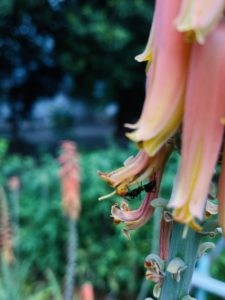
It was Saturday morning and I was concentrating on lunch prep when my phone rang.My friend Divya had spotted several stalks of aloe Vera flowers in bloom in our drive way and she was calling to ask if I knew that it was edible.I did not know that it was. What followed thereafter was an interesting conversation about how the local keerai vendors in Tirupur would come to the doorstep with these flowers in their baskets. She said she would ask her mom for the recipe and get back to me.
I went back to my cooking but the curiosity towards the Aloe Vera flowers just would not leave my head. I did manage to last the weekend without trying to find more info but once Monday morning dawned, the search for Aloe Vera flowers was one of the things that occupied me aside from my content writing. I did find one recipe on you tube for a typical Indian stir fry using the Aloe Vera flowers and a few other articles but it really did not tell me as much as I needed to know.
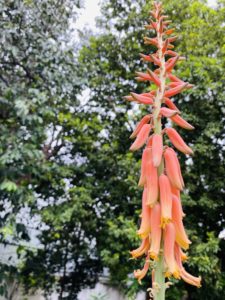
There are a few people who I turn to for information on native foods and I usually do end up getting a great deal of firsthand information. The person who pointed me in the right direction ,this time, was Saravanan , a true conservation and wild life enthusiast who is passionate about highlighting traditional practices in every sphere.
Though Saravanan had never tasted the Aloe Vera flowers he gave me the contact number for Rama Shanmugam Ayya who is known to be an expert in the field of all things related to Aloe Vera. By then I had done a lot of reading and spoken to people from all walks of life. A lady farmer said that her mother in law taught her to make a dish using Aloe Vera flowers and they referred to it as “katthalae poriyal”. The Aloe Vera is commonly referred to in Tamil as ‘sothu katthalae’. From ailments ranging from stomach and skin to hair and immunity, the Aloe Vera is one powerful ingredient for maintaining great health.
That was all what I knew before talking to the learned gentleman. He turned out to be not just a walking encyclopedia on all things Aloe Vera but he actually practices it on a daily basis. Apparently it started over 25 years ago when he had gone to a conference in New Delhi. He remembers how the trip left him completely amazed at how little we know of our indigenous plants. He talks of the effects of colonisation on our traditional foods. Even the names have slid into oblivion ,he says.
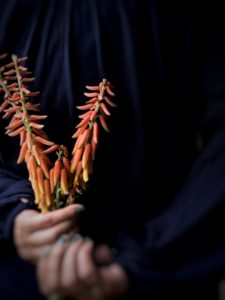
The Aloe Vera plant consists of so many varieties. It’s not just the one that we know of as Aloe Vera. The variety in which the flowers are edible is the Aloe Vera Barbedensis ,the original tamil name being Nat kumari. Shanmugham Ayya says the different kinds of native (to the South) Aloe Vera used to thrive in abundance near Kanyakumari ,in lands which are now submerged under the sea. Many of these were carried, back then, by merchants , across the seas ,to the European continents and apparently have resulted in the several hybrids which exist today .
Out of the other native species,the vaan kumari , paal kumari and sen kumari (mentioned in Siddha medicine) the lone surviving species is the nat kumari .This is why he continues to work hard to preserve it. There are also apparently other indigenous varieties in Rajasthan and Assam which are suited to and used in the local cuisine there.
He is now involved in working with farms to ensure that the Aloe Vera regains its place in the agricultural landscape. He campaigns extensively and propagates the Aloe Vera Barbedensis (nat kumari) .
Since I wasn’t sure what variety we had growing at home, Ayya said to look for a few physical characteristics. The thorns on the side of the gel filled leaves must be soft to the touch. The flowers of the native variety are yellow to a pale orange ,not a vibrant red or pure yellow. And lastly the plant itself is a more parrot green ,not a dark green or a pale whitish green. We passed the physical ! He said the real test lay in the taste. It should not be bitter.
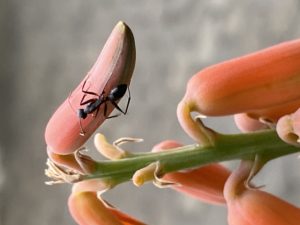
While putting our Aloe Vera plants through intense scrutiny for at least half an hour ,I seemed to have annoyed the big black ants who until now had obviously been enjoying complete monopoly. One big muscular chap made his intentions very clear and would not allow my fingers to rest on the blossoms which I was holding. After watching him for a few seconds I had to stop to take some pictures as proof. This went on for a while and I decided to leave him and his cluster of flowers in peace.
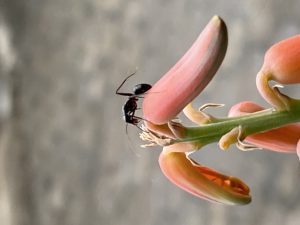
After picking a small bowl full of the pretty blossoms, stalk and all, it was time to get cooking. Shanmugham Ayya said that it is cooked in different ways, it can be made into a simple poriyal with fresh coconut or cooked with some native greens and lentils .The poriyal seemed the ideal choice. He also said to ensure that it was steam cooked or boiled with turmeric and salt or soaked in lemon juice just to remove any toxins. To be on the safer side, we boiled it with a generous pinch of turmeric and salt and also soaked it in lemon juice.
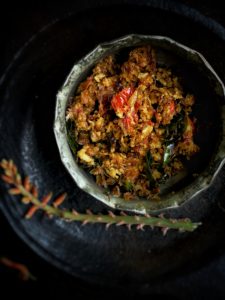
RECIPE FOR ALOE VERA POO PORIYAL </a
For tempering the flowers I went back to the youtube recipe where the lady uses large quantities of small onions, fresh green and red chillies , curry leaves and lots of grated coconut. I loved the look of that recipe.We had some beautiful ripe red chillies picked just that morning and the colour complemented the Aloe Vera flowers so beautifully.
The poriyal turned out so delicious that my help at home wanted the recipe to make for their family members. Apparently Aloe Vera grows easily in vacant plots around Coimbatore even today. I can’t wait for everyone to give this recipe a try.
The reason we need to go back to these recipes is not just for our health. Shanmugham Ayya says adding Aloe Vera to our diet offers more than a 100 health benefits. Apart from that it is also so important for us to identify with our native foods and recipes. They are delicious and tell a story about the food heritage and people of this part of the world. In a global community where we meet with folks who talk about wild foraged chanterelles or pale yellow country raspberries, wouldn’t it also be nice to showcase some of our own ?
Contact
Rama Shanmugham Ayya- 9362138926
Recipe link
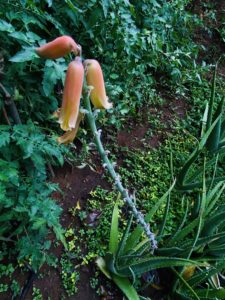

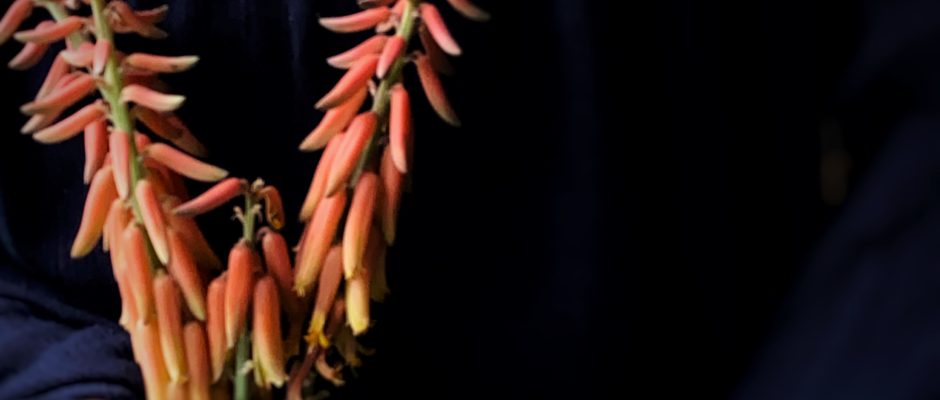
No comments yet.